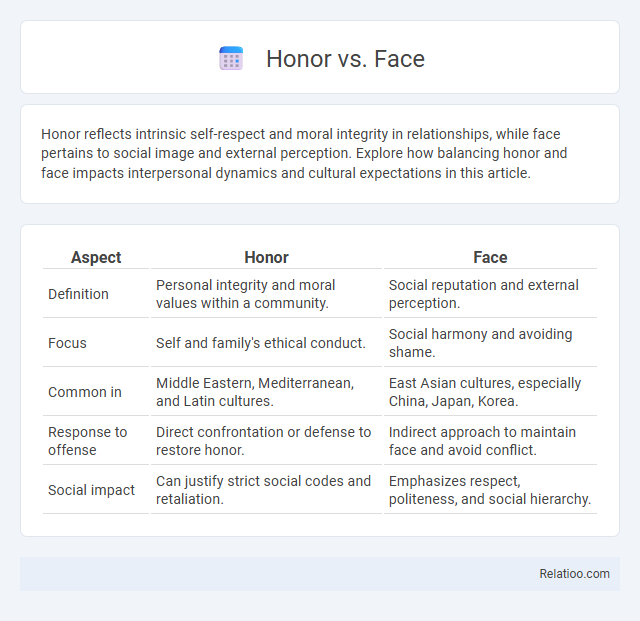Honor reflects intrinsic self-respect and moral integrity in relationships, while face pertains to social image and external perception. Explore how balancing honor and face impacts interpersonal dynamics and cultural expectations in this article.
Table of Comparison
| Aspect | Honor | Face |
|---|---|---|
| Definition | Personal integrity and moral values within a community. | Social reputation and external perception. |
| Focus | Self and family's ethical conduct. | Social harmony and avoiding shame. |
| Common in | Middle Eastern, Mediterranean, and Latin cultures. | East Asian cultures, especially China, Japan, Korea. |
| Response to offense | Direct confrontation or defense to restore honor. | Indirect approach to maintain face and avoid conflict. |
| Social impact | Can justify strict social codes and retaliation. | Emphasizes respect, politeness, and social hierarchy. |
Understanding the Concepts: Honor and Face
Honor represents deep-rooted cultural values linked to personal integrity, social standing, and moral conduct, often influencing how society perceives you. Face involves the public expression of respect, dignity, and reputation, crucial in maintaining social harmony and interpersonal relationships. Understanding the interplay between honor and face helps you navigate social dynamics sensitively, preserving both your self-worth and community acceptance.
Historical Origins of Honor and Face
The historical origins of honor and face are deeply rooted in diverse cultural traditions, with honor often linked to medieval European codes of chivalry and personal reputation, while face originates from Confucian ideals in East Asian societies emphasizing social harmony and respect. Honor historically dictated one's social standing and moral worth through external validation of bravery, loyalty, and integrity, whereas face focuses on maintaining dignity and avoiding shame within community relationships. Understanding these distinctions can help you navigate social interactions by recognizing when to uphold honor or prioritize face-saving measures to preserve social cohesion.
Cultural Contexts: East vs West
Honor in Eastern cultures emphasizes collective reputation and social harmony, deeply rooted in family and community values, while Western notions of honor often prioritize individual integrity and personal achievement. Face in Eastern contexts relates to maintaining social respect and avoiding shame, heavily influencing behavior and communication styles to preserve group cohesion. Your understanding of face-saving differs accordingly, as it involves subtle, indirect methods in the East to prevent loss of dignity, whereas Western cultures may address conflicts more openly to protect personal pride.
Social Dynamics of Honor
Honor functions as a social currency within communities, influencing behavior and status through adherence to cultural values and expectations. Face represents an individual's projected social image, which can be distinct yet closely tied to collective notions of honor in maintaining social harmony. Face-saving strategies emerge as critical mechanisms to navigate conflicts, preserve reputation, and uphold both personal and group honor in complex social interactions.
The Role of Face in Interpersonal Relationships
Face in interpersonal relationships functions as a critical social currency that influences trust, respect, and cooperation between individuals. Preserving face involves managing one's self-image and social identity to avoid embarrassment or loss of respect, thereby maintaining harmony and mutual understanding. Unlike honor, which is often tied to moral integrity, or face-saving, which is reactive, face serves as a proactive mechanism shaping social interactions and group cohesion.
Honor and Face in Conflict Resolution
Honor in conflict resolution emphasizes an individual's or group's reputation and moral integrity, driving actions to maintain respect and social standing. Face refers to the public self-image or dignity one wants to preserve in social interactions, influencing behaviors aimed at avoiding embarrassment or shame. Effective conflict resolution balances honor and face by addressing underlying values and ensuring all parties can maintain dignity while resolving disputes.
Language and Communication: Expressing Honor and Face
In language and communication, expressing honor and face involves the careful use of politeness strategies, indirect speech, and honorifics to maintain social harmony and respect. Honor is often conveyed through formal titles, respectful terms, and culturally specific speech acts that acknowledge status or achievement, while face-saving tactics mitigate potential embarrassment or conflict during interactions. Understanding these linguistic nuances is essential for effective intercultural communication, as they reflect underlying social values and power dynamics.
Consequences of Losing Honor vs Losing Face
Losing honor often results in long-term damage to your reputation and social standing, impacting trust and relationships within your community. In contrast, losing face typically involves a temporary embarrassment or loss of dignity, which can be recovered through corrective actions or apologies. Understanding the consequences of each helps you navigate social interactions and maintain respect in various cultural contexts.
Evolving Practices in a Globalized World
Honor, face, and face-saving have evolved significantly in a globalized world, reflecting changing social norms and intercultural interactions. Honor traditionally involves adherence to moral or social codes, while face refers to an individual's public self-image, and face-saving strategies help maintain dignity during conflict or embarrassment. Globalization drives hybrid practices where collective honor blends with individual face concerns, necessitating adaptive communication skills across diverse cultural settings.
Honor and Face: Contemporary Relevance and Challenges
Honor and face remain critical cultural constructs influencing social interactions and personal identity, particularly in East Asian and Middle Eastern societies where maintaining honor and face shapes behavior and decision-making. Challenges arise as globalization and modern values intersect with traditional notions, creating conflicts between individualism and collective expectations of honor and face preservation. Navigating these tensions requires a nuanced understanding of cultural contexts to effectively address issues in diplomacy, business, and interpersonal relationships.

Infographic: Honor vs Face
 relatioo.com
relatioo.com